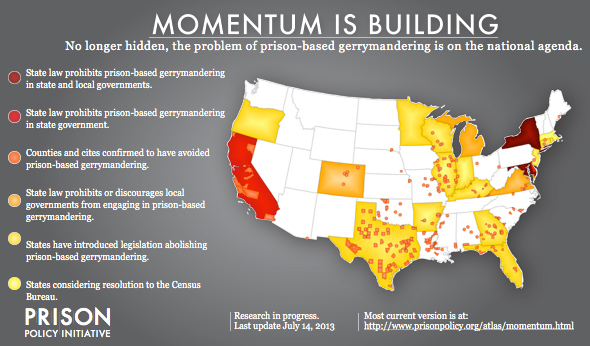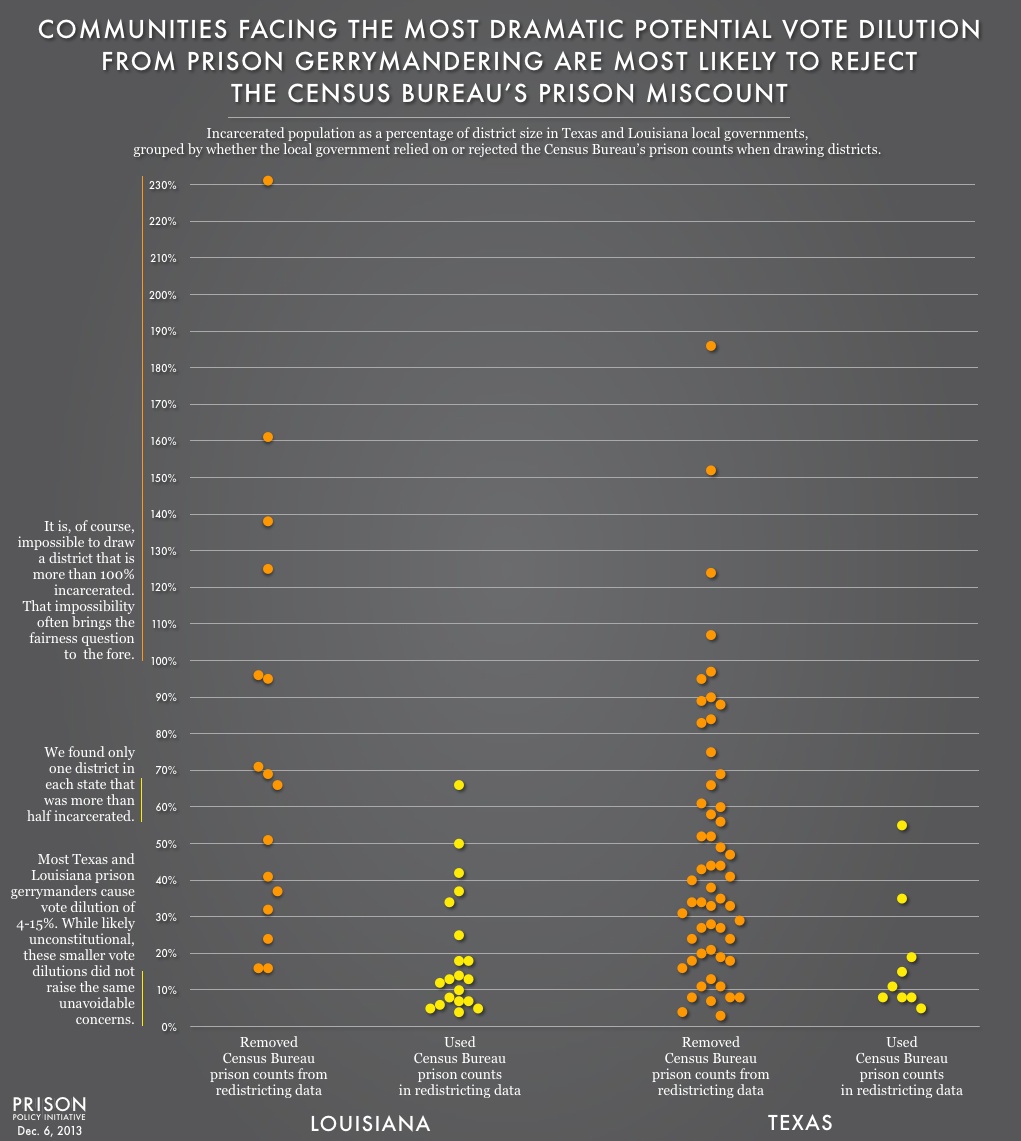Avoiding prison gerrymandering is often a matter of common sense: Texas and Louisiana research update
New data shows that communities facing the most dramatic potential vote dilution from prison gerrymandering are most likely to reject the Census Bureau’s prison miscount
by Peter Wagner, December 6, 2013
Drawing a city or county district that contains only incarcerated people who are from elsewhere doesn’t make any sense. Our research for an upcoming law review article on prison gerrymandering in local governments is finding that local governments faced with such absurd predicaments are leading the way in the national movement against prison gerrymandering.
In the decade that we’ve been working with state and local governments to document the extent of, and develop solutions to, the problem of prison gerrymandering, we’ve noticed a strong trend that makes a lot of sense: the bigger the potential problem, the more likely a jurisdiction is to address it. It should therefore come as no surprise that more than 200 communities across the country currently reject prison gerrymandering as seen here:
We’re currently working on a detailed 50-state overview of how local governments deal with prison gerrymandering. But our results for Texas and Louisiana are so clear that I wanted to share them now as a preview. This post summarizes how Texas and Louisiana counties, parishes, municipalities and school districts that contain large prisons addressed the Census Bureau’s inclusions of thousands of non-voting non-residents as part of their community.
I choose Texas and Louisiana for this research summary for two reasons: because both states contain a large number of jurisdictions where prison gerrymandering is potentially an issue, and because, like in most states, those local governments are entirely free to choose whether or not to rely without question on the Census Bureau’s data when redistricting.
Adjusting the Census to draw districts without the prison population isn’t just common sense, it also has a basis in how state laws defines residence. In these two states, for example:
“For purposes of the laws governing voter registration and voting, ‘resident’ means a citizen who resides in this state and in the parish, municipality, if any, and precinct in which he offers to register and vote, with an intention to reside there indefinitely.” (Louisiana Annotated Revised Statutes S 18:101(B).)
“‘[R]esidence’ means domicile, that is, one’s home and fixed place of habitation to which one intends to return after any temporary absence…. A person who is an inmate in a penal institution… does not, while an inmate, acquire residence at the place where the institution is located.” (Texas Annotated Code S1.015(e).)
In fact, once local governments engage the problem of prison gerrymandering, they often show great enthusiasm for comprehensive state-wide solutions. Connecting these rural leaders with their state legislators is often the key to the rural-urban state legislative coalition for reform.
As the below scatterplot of our research findings shows, the more dramatically the Census Bureau’s prison counts threaten to undermine a jurisdiction’s electoral districts, the more likely the place is to exclude those counts when redistricting:
In Louisiana, most local governments that faced especially dramatic instances of prison gerrymandering overwhelmingly chose to adjust the census to avoid padding their districts with incarcerated populations. Most of prison gerrymanders we found in Louisiana local governments resulted in relatively smaller impacts. This local trend against prison gerrymandering is even clearer in Texas: 86% of the communities we investigated rejected prison gerrymandering, including communities that had potential vote dilutive impacts as low as 2.6%.
Of course, there are always exceptions to any rule. Stay tuned for my law review article that will address the notable exceptions and link them to unique but unfortunate constitutional clauses, state statutory language or city charters that require local governments to use knowingly false data and dilute the votes of their own residents. Those exceptions are interesting and speak to why the ultimate solution needs to come from the Census Bureau. But the data we’ve summarized makes the trend really clear.






Excellent article and website! Please keep up the good fight.
This is part of the larger problem- that the districts are being “drawn” by selfish interests, who can game the rules to reinforce their positions of influence in government. Much of this could be eliminated by the fairly straightforward expedient of leaving redistricting to “hands-off” algorithmic processes that set the rules for fairness ahead of time, and leave it to computers to do the work. Trivially easy these days, and lots of creative options have appeared for making it work.
Please go to handsoffredistricting.org and leave a comment on how prison gerrymandering could be handled fairly in a hands-off approach, or take a look at youtube.com/watch?v=xwE5twJj4Kw
Hi Noah,
I absolutely agree that prison gerrymandering is just one way to gerrymander and that gerrymandering is the problem.
And I want to draw folks’ attention to the subtitle of your site: “They’re OUR Congressional Districts – Politicians just work in them”. That’s exactly the point of districting. Although elected officials often act and speak otherwise, the districts belong to the people, not the representatives. I think it’s important to continually make this point and not to fall into the shorthand of calling District X “Sue’s district” because I think that sets back the longterm reform efforts…. So thank you!
That said, I worry that automated redistricting methods will be very bad for minority voting rights. I understand the rationale in your proposal of using Census tracts at the basis of the districts, but that’s often been found to be in conflict with maximizing minority representation. If we are going to think outside the box about getting rid of gerrymandering, why not go further and just get rid of districts? Proportional representation would solve all of these problems and more.
(And on a side note, prison gerrymandering tends to have very little effect on Congressional districts, which is where I think you are focused. Congressional districts tend to be too big to be skewed much by most clusters of prisons. Congressional districts are basically the opposite of these county commissioners court and parish police jury districts that can easily be 90% of more incarcerated. Of course, the issue of self-interest in redistricting applies at all levels of government.)
[…] Our recent research shows that local governments see prison gerrymandering as not only unfair, but that it defies common sense. Tilove found much of the same attitude: “It didn’t seem fair to me to include that population in any precinct because their residence was not established voluntarily, and, since they are convicted felons, they don’t have the right to vote,” said Bill Coleman, the Hale County judge. “If your altruistic goal is to try to make each precinct have an equal number of at least potential voters, and a significant chunk of your population is not allowed to vote, aren’t you sort of undermining the whole purpose of this thing?” […]